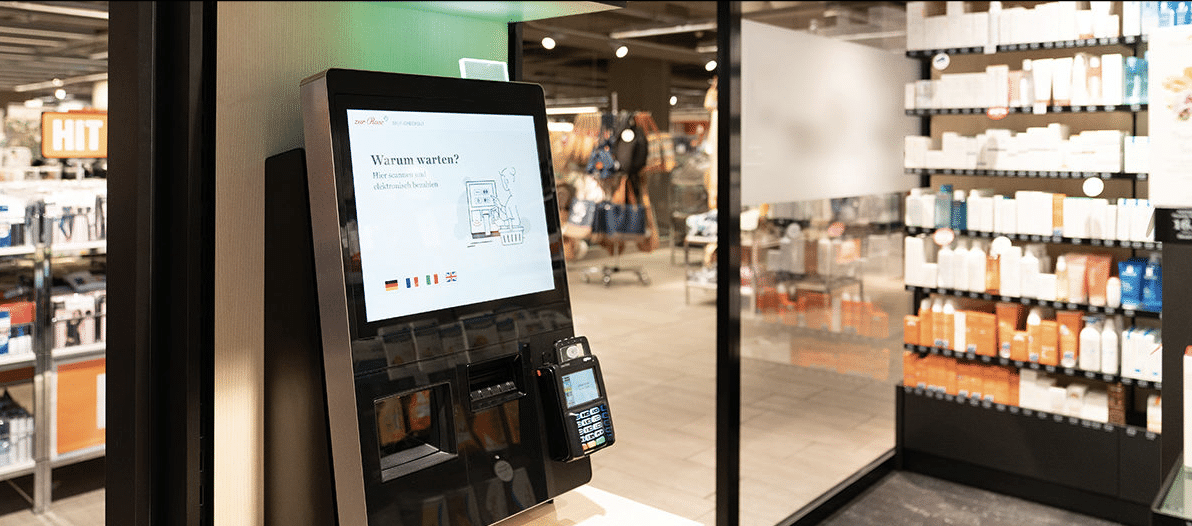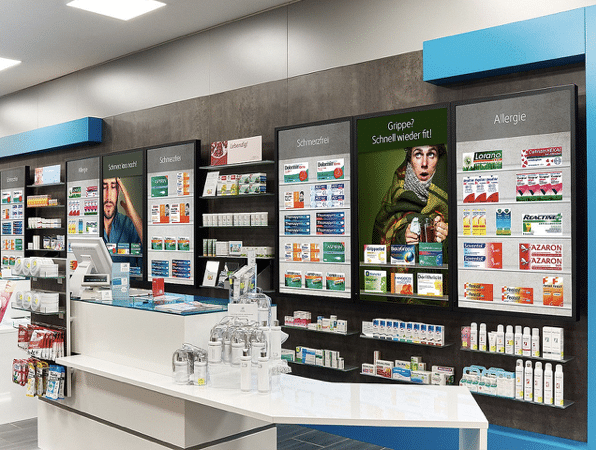Information technology trends: Digital solutions in pharmacies
Self-checkout in pharmacies: with new digital recipes for success
They are part of a larger change in appearance and product portfolio: Digital solutions are intended to help ensure that stationary pharmacies continue to be perceived as attractive institutions in the future. These tools include payment terminals for self-checkout.
 The new article in the retail magazine of the EHI Retail Institute provides exciting current insights into the information technology trends of pharmacies. Read more here! You can find the original article here.
The new article in the retail magazine of the EHI Retail Institute provides exciting current insights into the information technology trends of pharmacies. Read more here! You can find the original article here.
Self-service checkouts, as they are currently increasingly used in the food trade, can also be a sensible solution for pharmacies. This is the thesis of Dirk Bockelmann, Managing Director of BD Rowa, a company based in Kelberg that specializes in automated warehouses (picking systems). “Especially for pharmacies with a large free-choice portfolio, i.e., products that do not require a prescription or consultation, a self-checkout solution makes sense,” argues the expert. This could be the case, for example, for heavily frequented center pharmacies, but also shop-in-shop pharmacies in the food trade, which are currently appearing more and more in Europe.
More and more consumers are familiar with the technology and procedures at self-payment terminals. This opens the door to expansion and implementation in pharmacies. For Bockelmann, the arrival of these automated processes in pharmacies is part of a larger transformation currently taking place in the industry. Virtual shelves and walls, shopfitting elements with a boutique character or a panorama wall are details that were previously used more in upscale specialty retail with lifestyle products.
The background is the shift of more and more “transactional activities” to digital online channels. “Consumers are demanding and enjoy convenient ordering and delivery options. With regard to the e-prescription, in the future it will be even easier for patients to send the prescription digitally to a pharmacy and request delivery. Delivery expectations of between 30 and 120 minutes will be the new standard,” reports Bockelmann. Micro fulfillment centers in the neighborhood, possibly in the pharmacy’s back office, will process the orders and ensure delivery. Last-mile messenger services or pick-up stations can bridge the distance to the patient. “The recommendation to the pharmacy of the future is therefore to adapt to this change in terms of appearance and range of services in order to remain attractive as an institution,” says Bockelmann.
Open space on the floor
The market expert assumes that pharmacies will continue to expand the health and wellness offering in their product range. This includes primary care services, keyword testing & vaccination, as well as an extensive free choice in the areas of “Customer Care”, “Patient Care” and nutritional supplements. “Most likely, we will also see more offerings from the traditional medical supply portfolio in pharmacies. Because of the shift of the majority of prescription transactions to the microfulfillment area of the pharmacy, fewer cashier workstations will be needed.”
The sales floor, he said, will be needed even more than before for services and merchandise displays. Self-checkout, partly supported by consulting staff, creates the necessary free space on the sales floor and in the workflow. In the future, pharmacies will be able to concentrate more on human-to-human contact and advice for sustainable customer loyalty to the “pharmacy” brand. The pure payment transaction recedes into the background and is handled discreetly and efficiently by the self-checkout.
Place of encounter
According to Bockelmann, pharmacies should continue to position themselves as a place of encounter and service for people, unaffected by the pressure to change an entire sector of the economy. In this context, merchandise pressure, deep shelves and customer guidance concepts, such as those familiar from grocery stores and drugstores, play only a subordinate role. Literally: “The pharmacy of the future will be far from a drugstore set-up. The space will be designed around patients and services, and can be flexibly modified to meet individual needs. Self-checkout as one element can fit in there seamlessly.”
According to Bockelmann, the industry is currently driven by the goal of organizing the “last mile” as quickly, efficiently and profitably as possible in order to stay ahead of the looming competition from large online mail-order companies. “Self-checkout is a way for BD Rowa to show the vision of tomorrow’s pharmacy and position our robotics today.”
People remain at the center of attention
Pharmacists practice a healing profession. Digitalized processes are therefore at best “useful additions,” says Ulrich Obermüller, Managing Director of Pharma Consult Cologne.
Virtual shelves and walls, boutique character, panorama walls: What is happening in the world of pharmacies right now?
In the past, many processes in retail pharmacies were already digital, but mostly in the background and not tangible for customers. That is currently changing. Kleeblatt-Apotheken, one of our partners, also uses software for digital price labeling, for example. App-based offerings and the introduction of virtual sight selection are planned for the future.
When does a self-checkout solution make sense for pharmacies?
Large, modern retail spaces with high customer traffic already benefit from self-checkouts, which give customers who are determined to buy a greater sense of freedom. At the same time, a digital payment system gives staff more time to spend with customers who need advice. The challenge is to combine the advantages of the consultant pharmacy and the digital shopping world in a meaningful way.
According to your findings, what relevance do instruments, solutions and media have around the topic of digitization and automation?
The haptics of products still play a major role, especially with older customers. At the same time, however, younger target groups must also be addressed. Here, interactive functional surfaces signal future orientation.

